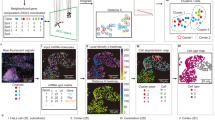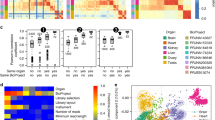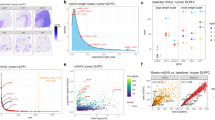Abstract
It is often supposed that, except for tandem duplicates, genes are randomly distributed throughout the human genome. However, recent analyses suggest that when all the genes expressed in a given tissue (notably placenta1 and skeletal muscle2) are examined, these genes do not map to random locations but instead resolve to clusters. We have asked three questions: (i) is this clustering true for most tissues, or are these the exceptions; (ii) is any clustering simply the result of the expression of tandem duplicates and (iii) how, if at all, does this relate to the observed clustering of genes with high expression rates3? We provide a unified model of gene clustering that explains the previous observations. We examined Serial Analysis of Gene Expression (SAGE)4 data for 14 tissues and found significant clustering, in each tissue, that persists even after the removal of tandem duplicates. We confirmed clustering by analysis of independent expressed-sequence tag (EST) data. We then tested the possibility that the human genome is organized into subregions, each specializing in genes needed in a given tissue. By comparing genes expressed in different tissues, we show that this is not the case: those genes that seem to be tissue-specific in their expression do not, as a rule, cluster. We report that genes that are expressed in most tissues (housekeeping genes) show strong clustering. In addition, we show that the apparent clustering of genes with high expression rates3 is a consequence of the clustering of housekeeping genes.
This is a preview of subscription content, access via your institution
Access options
Subscribe to this journal
Receive 12 print issues and online access
$209.00 per year
only $17.42 per issue
Buy this article
- Purchase on Springer Link
- Instant access to full article PDF
Prices may be subject to local taxes which are calculated during checkout


Similar content being viewed by others
References
Ko, M.S.H. et al. Genome-wide mapping of unselected transcripts from extraembryonic tissue of 7.5-day mouse embryos reveals enrichment in the t-complex and under-representation on the X chromosome. Hum. Mol. Genet. 7, 1967–1978 (1998).
Bortoluzzi, S. et al. A comprehensive, high-resolution genomic transcript map of human skeletal muscle. Genome Res. 8, 817–825 (1998).
Caron, H. et al. The human transcriptome map: clustering of highly expressed genes in chromosomal domains. Science 291, 1289–1292 (2001).
Velculescu, V.E., Zhang, L., Vogelstein, B. & Kinzler, K.W. Serial analysis of gene expression. Science 270, 484–488 (1995).
Dandekar, T., Snel, B., Huynen, M. & Bork, P. Conservation of gene order: a fingerprint of proteins that physically interact. Trends Biochem. Sci. 23, 324–328 (1998).
Blumenthal, T. Gene clusters and polycistronic transcription in eukaryotes. BioEssays 20, 480–487 (1998).
The MHC Sequencing Consortium. Complete sequence and gene map of a human major histocompatibility complex. Nature 401, 921–923 (1999).
International Human Genome Sequencing Consortium. Initial sequencing and analysis of the human genome. Nature 409, 860–921 (2001).
Paul, A.L. & Ferl, R.J. Higher-order chromatin structure: looping long molecules. Plant Mol. Biol. 41, 713–720 (1999).
Fisher, R.A. The Genetical Theory of Natural Selection (Clarendon, Oxford, 1930).
Zavattari, P. et al. Major factors influencing linkage disequilibrium by analysis of different chromosome regions in distinct populations: demography chromosome recombination frequency and selection. Hum. Mol. Genet. 9, 2947–2957 (2000).
Hurst, L.D., McVean, G.T. & Moore, T. Imprinted genes have few and small introns. Nature Genet. 12, 234–237 (1996).
Schuler, G.D. et al. A gene map of the human genome. Science 274, 540–546 (1996).
Lash, A.E. et al. SAGEmap: a public gene expression resource. Genome Res. 10, 1051–1060 (2000).
Duret, L., Mouchiroud, D. & Gouy, M. HOVERGEN: a database of homologous vertebrate genes. Nucleic. Acids. Res. 22, 2360–2365 (1994).
Acknowledgements
We acknowledge support by the Wellcome Trust (MJL), CONACyT and ORS (AOU), and BBSRC (LDH).
Author information
Authors and Affiliations
Corresponding author
Ethics declarations
Competing interests
The authors declare no competing financial interests.
Supplementary information
Rights and permissions
About this article
Cite this article
Lercher, M., Urrutia, A. & Hurst, L. Clustering of housekeeping genes provides a unified model of gene order in the human genome. Nat Genet 31, 180–183 (2002). https://doi.org/10.1038/ng887
Received:
Accepted:
Published:
Issue Date:
DOI: https://doi.org/10.1038/ng887
This article is cited by
-
Extensive fragmentation and re-organization of transcription in Systemic Lupus Erythematosus
Scientific Reports (2020)
-
Dosage sensitivity of X-linked genes in human embryonic single cells
BMC Genomics (2019)
-
The distributions of protein coding genes within chromatin domains in relation to human disease
Epigenetics & Chromatin (2019)
-
Overlapping protein-coding genes in human genome and their coincidental expression in tissues
Scientific Reports (2019)
-
Intrachromosomal colocalization strengthens co-expression, co-modification and evolutionary conservation of neighboring genes
BMC Genomics (2018)



